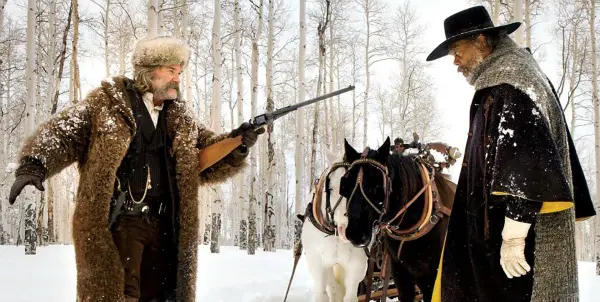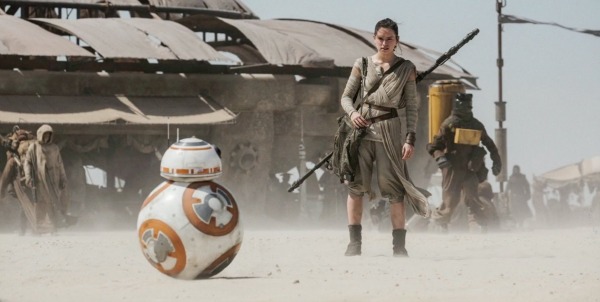STAR WARS, THE HATEFUL EIGHT And Cinematic Comfort Food

Jay is just a dude who takes in an unhealthy…
Walking out of the theater after my opening night showing of Star Wars: The Force Awakens, I felt like I had received a warm hug for two hours. It was comforting to see a director perfectly capture the classic energy and hope of Star Wars for the first time in thirty years.
I grew up as a fan of Star Wars, but I was far from the type of “super fan” who continues to buy toys, posters, dog costumes, onesies, and remote-controlled soccer ball droids (granted, if someone sent me that rolling BB-8, I would accept it with open arms). The criticisms of The Force Awakens being derivative of the original trilogy are fair, even if the deviations and fabulous new characters are more than enough to overcome that issue, in my mind.
Falling in line with expectations can be very comforting; it is a calm in the middle of the storm that is the world of cinema. But for what reason, if any, should film keep us comfortable?
A Hateful First Experience
The way I felt after The Hateful Eight was the polar opposite of the way I felt after The Force Awakens. If Star Wars gave me a warm hug, The Hateful Eight threw me in a cold shower and locked me inside for three hours. Quentin Tarantino has always been a subversive, polarizing director, but he turns his ambition and gravitas up to level 10 for The Hateful Eight.
The film’s title is very apropos, as there is not a fully likable character that is on screen for more than 20 minutes. Kurt Russell’s character, John Ruth, has charisma for days, but is also continually punching, elbowing, or otherwise beating Daisy Domergue (the film’s only prominent female character, played by Jennifer Jason Leigh) for the entirety of the film. The rest of the main characters in the film are racist, tyrannical, ruthless, lying, and/or conniving human beings who can be best classified as all-around terrible.
The Force Awakens operates in strict blacks and whites. It is good versus evil, just versus unjust. The Hateful Eight, meanwhile, operates in very, very dark shades of gray. I was squirming in my chair for much of the film, even as I was engaged for most of it. I still feel that it is Tarantino’s weakest work to date (which is still a compliment), but my opinion of it has changed since my first viewing.

I felt uncomfortable and sort of unhappy while I watched it, but there is value in discomfort. Casual racism and women beating is not supposed to be comfortable, and discomfort in the presence of the disturbing is valuable. Tarantino manages to find humor in these atrocities in ways that only Tarantino can, making the experience even more awkward, as you sit giggling while blood spews from the nose of Jennifer Jason Leigh.
Tarantino’s work has become increasingly angry and increasingly political, and that all comes to a head in The Hateful Eight. In Inglourious Basterds, Hitler is shot to shreds, in Django Unchained, a compliant slave owner is shot with a revolver and flies back 15 feet (“Tell Miss Laura Goodbye”), in The Hateful Eight, the most memorable moment of violence is a character we barely know whose motivations are halfway commendable getting his head blown off by a shotgun at point blank range.
Hitler and slave owners are abstracts whose deaths we barely flinch at. We have no preconceived notions about Channing Tatum’s character; it is the brutal murder of a man we barely know, whose death we are not sure is fully deserved because of all the lies that are slung around over the course of the film.
There is no satisfying resolution in the most traditional sense, which is something that cannot be said of Tarantino’s other films, almost all of which have elements of a classic revenge tale with clear antagonists and protagonists (along with plenty of other characters that straddle the line between the two classifications).
American moviegoers have come to expect a paint-by-numbers form of presentation, even from many of the most unique filmmakers. I have come to expect a (large) degree of empathy in film, which is almost nonexistent in The Hateful Eight. It is the ant-Star Wars. I admire Rey, Finn, Poe, and BB-8. I admire exactly zero characters in The Hateful Eight (and actively loathe some of them), and this really irked me upon first viewing, but now I have an idea of why he wrote the characters the way he did.
It provides the blunt force trauma that makes The Hateful Eight so effective in just the way Tarantino wants it to. He is angry about race relations and he hates the current state of American law enforcement. There is a strangely optimistic ending when a black man and white sheriff are able to join forces and dish out “frontier justice”, no matter how discomforting that justice is to watch. The Hateful Eight is Tarantino’s least watchable film, but it is also his most thematically relevant.
The Forces Embraces
Whereas The Hateful Eight was uncomfortable and provocative, Star Wars: The Force Awakens is comforting and innocent. The Force Awakens was one of my favorite films of the year, but it is also the least interesting. It is exactly what we expected, which is to be admired in its own way, considering the way we have come to admire George Lucas’ original trilogy.

It copies the original, but also flips it on its head enough to live on its own. I loved Han Solo’s role in the new movie, but it was undoubtedly about the new characters, who present layers that no other character in the Star Wars universe have presented. There are good guys and bad guys, and these roles are further established when Han Solo’s son stabs him in the chest, but the motivations are far more interesting than almost any of the previous characters.
The characters were a tad more nuanced, but the sides were easy enough to identify that it felt like the films we are used to. It has not been banging around in my brain like The Hateful Eight, but that is not necessarily a bad thing. I was moved by The Force Awakens as much as I was by any other film of 2015.
Call me a sucker. Call me sentimental. Whatever you call me, I was broken up by the death of Han Solo and driven to goosebumps by the first appearance of Mark Hamill as Luke Skywalker in over thirty years. There is no responsibility for a movie to make us comfortable, but there is no reason for a film to make us uncomfortable.
Cynicism doesn’t equal quality
It is completely unreasonable for a film’s ability to make us squirm be a reflection of its quality. It is very interesting when a film subverts our expectations, but that is far from the only qualification for a truly great film. Directors like Tarantino are very adept when it comes to shocking audiences, but there is a place for tremendously crafted films like The Force Awakens that present stories that we are familiar with but change just enough to capture the sense of wonder that we have felt for the films that have come before it, while still moving the story forward and leaving a huge number of loose ends moving forward.
So many people have written off The Force Awakens as a derivative film that doesn’t have any idea which direction it is moving, when it is actually a movie that is so sure of its ideas moving forward, no matter how classic the themes may be. Drab and cynical has become the norm for “quality” when that is a complete misnomer.

John Ford and Frank Capra films were filled with overt optimism, but their films are universally regarded as classics. There is no reason that films of that ilk should be disregarded in the way that The Force Awakens has among many hardcore film fans. Art as entertainment is valuable, just as art that mirrors society in unsettling ways is valuable.
The Hateful Eight Awakens
It took multiple viewings to interpret The Hateful Eight, but multiple viewings of The Force Awakens just reinforced the tremendous experience of the first viewing. I don’t enjoy The Hateful Eight as much as I appreciate it, whereas the opposite is true of The Force Awakens. But who is to say what is more valuable?
I will think about The Hateful Eight more than The Force Awakens, but I will watch The Force Awakens twice as much. The Force Awakens is a well thought out piece of pulp, while The Hateful Eight is a great, insightful script with tremendous performances that makes me want to crawl into a ball.
The Hateful Eight will not maintain a place in pop culture like Pulp Fiction has or Inglourious Basterds will (or certainly not to the degree that The Force Awakens will) but it will be criticized by the academics as much as any of his films. Film has no responsibility to make us feel good, but it should not be penalized for doing so. Great characters and a great story are valuable, no matter how uncomfortable or unsettling a film is. May the force be with you, no matter how hateful your spirit may be.
Thoughts?
Does content like this matter to you?
Become a Member and support film journalism. Unlock access to all of Film Inquiry`s great articles. Join a community of like-minded readers who are passionate about cinema - get access to our private members Network, give back to independent filmmakers, and more.
Jay is just a dude who takes in an unhealthy amount of media of all types. Currently living in Atlanta, Georgia, he firmly believes that all movie theaters should have leather recliners, you eat popcorn too loudly, and if you don't put that cellphone away in 2 seconds you will learn the definition of frontier justice.













